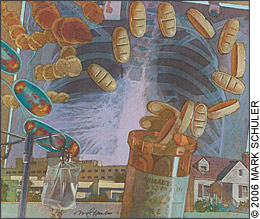
Am Fam Physician. 2006;73(3):371
Everyone involved with AFP is dedicated to continuous quality improvement. We want and need to know what AFP readers want in their publication. One of the many ways we obtain input from readers is by conducting a survey of visitors to the publications booth at the American Academy of Family Physicians’ annual Scientific Assembly. The results of these surveys allow us to identify trends and determine where and how to spend our time and resources. I’d like to take this opportunity to share just a few of the results with you.
2005 Assembly Survey Results
In addition to distributing the survey to Assembly attendees, we published the survey in the October 1, 2005, issue of AFP to obtain input from more readers. A total of 548 readers completed the survey; 298 filled out the survey at Assembly, and 250 completed the survey published in the October 1 issue. Here are some of the reader responses.

Almost two thirds (63.0 percent) of respondents read 19 or more issues a year; 49.8 percent read all 24 issues. This is up from 2004 figures, which showed that 49.0 percent read 19 or more issues per year. It is important to note, however, that the 2004 survey was conducted at Assembly only.
Eighty-six percent of respondents find information they can put to use in their practice in every issue or most issues.
Forty-four percent of respondents keep a library of back issues, and more than one third save selected articles. These numbers have declined in the past few years, probably because of increased use of the AFP Web site, which provides the full content of AFP online.
Ninety percent of readers still prefer to read AFP in print; 9 percent prefer to read it online.
The average amount of time spent reading one issue of AFP is 2.31 hours.
More than 75 percent of readers return at least some clinical quiz cards; of those, 41 percent complete 13 to 24 cards during one year.
Approximately 70 percent of respondents who are familiar with Strength of Recommendation Taxonomy tables find them very or somewhat useful.
More than 30 percent of respondents give AFP patient education handouts to patients at least once a week. Of those, 40 percent obtain handouts from the AFP Web site.
Besides clinical review articles, many AFP regular departments are widely read. According to the survey results, the most popular routine departments were “From the U.S. Preventive Services Task Force” (read by 59.3 percent); “POEMs” (58.4 percent); “Photo Quiz” (58.2 percent); “Practice Guidelines” (57.8 percent); and “Cochrane for Clinicians” (55.5 percent).
Do You Agree? Don’t Wait for a Survey to Give Us Your Opinion!
We welcome input from all readers to help guide the content ofAFP. But don’t wait for a formal survey. You can send us your comments and suggestions 24 hours a day, seven days a week. The general e-mail address for AFP isafpedit@aafp.org; you also can return the comment card included in every issue. If you have an idea for an article, please send your query to the Editor atafp@family.georgetown.edu.
editor’s note: Thank you to the Publications Division marketing staff for survey data analysis.